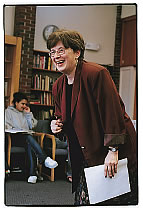 |
| | |
 |
|
 |
 |
 |
THIS
SEMESTER
|
 |
 |
| photo by Rose Lincoln |
| |
|
COURSE: Drama
& Improvisation
DEPARTMENT:
Child Development
Professor: Kathleen
Camara
Associate Professor
by Laura
Ferguson
How
do you work drama and improvisation into a classroom setting?
I usually start off the semester immediately with an improvisation.
It can take the students a while before they realize what’s
happening because I come in and I usually tell them about something
that’s happened to me that day—my car broke down
and I ran through all sorts of difficulties. And they are wondering:
Why is she telling us all this? Then I tell them that I finally
called this company that brought me an elephant and I had to
ride into work on it. And then I proceed to tell them how frightened
I was about getting up on the elephant, and eventually some
of them will realize that it’s improvisation and start
asking me more questions, or sharing their own stories.
What are you trying to
teach through improvisation?
I’m trying to teach them skills they can use when they
work with children. That’s one strategy—actually
engaging them in improvisation. Another is to have them participate
in what I would have children participate in as well, which
might be some creative dramatic activities. Knowing how to use
movement, how to pretend, how to use their imagination. I employ
a lot of those kinds of improvisational games, too. Asking them
to pretend they are a piece of bacon frying, or popcorn that
has just been put into a pot, or candles melting, or leaves
that are being swept up in a storm—asking them to use
their bodies and their imagination to enact some of these things.
They also have readings, so they are getting thetheoretical
parts of what it means to use drama. But improvisations in the
beginning are part of that skill-building that helps them understand
how to establish a suspension of disbelief in the group.
What do you mean?
Well, it’s not that we’re trying to get everyone
to believe that what we’re doing is actually real; we’re
coming to an agreement that we’re going to suspend our
disbelief in order to create the drama. And that’s the
kind of impression that you want to give to children as well,
although with children it’s much easier because they are
very willing to enter into that.
What ages are the children you
work with?
This year the first group of children were ages five and six;
another group was eight, nine, and ten; and, finally, a group
of teenagers will come in. And sometimes we go to the Eliot-Pearson
children’s schools and observe what goes on there in play.
Kids take play very seriously,
don’t they?
Play is children’s work. It is the way in which they are
able to begin to understand the world. If there’s a sadness
or a death, a loss of some kind that occurs in life, they would
use play as a way to be able to process that. They don’t
have the same coping mechanisms that we have as adults and so
play is basically one of those ways of being able to address,
respond to, and cope with stressful events. As well as to celebrate
things that are really kind of fun. We all do it in different
ways. When I asked my students this year, Do you engage in spontaneous
kinds of dramatic play, they weren’t too sure about that.
Well, what do you do when you are about to go into a job interview?
Do you start to imagine yourself in that situation? Do you go
through a series of dialogues with yourself such as, what are
they going to ask me and what are they going to say? That’s
all part of that rehearsal that occurs when you’re about
to try on or do a new experience.
Do students have a final project?
They do, but I leave that open-ended and I’m always very
impressed by what they come up with. For example, I’ve
had students actually write a musical play for children—write
all the music, write the lines or the questions that would be
asked for an improvisation, and develop a whole piece. Or I’ve
had students adapt something like The Lion King. They
might take The Lion King and say, How can we make this
a third-grade production? I’ve had students work with
a group of children for a number of weeks and basically they
document what that process is about. They might videotape themselves
and analyze those videotapes: what things happened and whether
they were really able to deepen the children’s involvement
in creating the drama. Some students have found stories that
they think are appealing to children and then presented them
as story theater.
What’s your goal for the
class as a whole?
It’s really about engaging students in such a way that
they are willing to take risks; that they are willing to step
out and do something a little different, to feel comfortable
using their own imaginations so that they can allow children
to do the same. I’m hoping that what they will do in the
end is be able to share that experience with children, whether
it’s in a museum, a school, or—because I have premed
students in the class—a hospital or doctor’s office.
There’s always room for using some dramatic play in each
of these settings. If the students learn to take risks to help
children explore and learn from their dramatic experiences what
it might have been like to live during the French Revolution
or how the early pioneers must have felt when they left their
homes behind or to understand the “universals” of
human experiences, then I can feel we have accomplished an important
objective of drama—the “living through” of
experiences.
|
 |
 |
 |
|
|
 |

